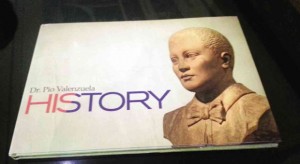MANILA, Philippines–The city that bears his name commemorates his 145th birth anniversary Friday, but the house of Dr. Pio Valenzuela remains in a state of neglect. Yes, it is still standing, but it looks far from being a historic shrine that the Valenzuela City government hopes it to be.
Valenzuela was part of the Katipunan triumvirate—together with the Supremo Andres Bonifacio and secretary Emilio Jacinto—who formed the core leadership of the secret society that rose up against Spanish colonial rule. The physician and patriot was born on July 11, 1869, and died on April 6, 1956, at age 86.
The two-story house is located on a 736-square-meter lot in Barangay (village) Pariancillo Villa (once part of Polo, Bulacan province), where it is identified merely by a marker stating its famous former occupant. Take off the sign and it’s just another abandoned, time-worn structure by the river, with the yard and ground floor perennially flooded and strewn with water hyacinths.
Jonathan Balsamo, curator of the city museum, said the local government had long been planning to restore the house, but it could not just proceed since the property remains privately owned.
He also noted that the house people see today is actually just a reconstruction of the ancestral residence that burned down during World War II.
“We have been receiving comments from people, especially in social networks, saying we’ve been taking this historic site for granted,” Balsamo said. “But the city government cannot just

The Katipunan leader’s old house in Barangay Pariancillo Villa is perennially flooded and overgrown with water hyacinths.
easily renovate the house because it’s still on private property.”
After Valenzuela’s death, ownership of the property was transferred to his six children—all of whom have already passed on—and later to the grandchildren, he said. “The last time we checked, there are 77 legal heirs who can claim ownership.”
Balsamo said majority of the heirs had already agreed to entrust the responsibility of maintaining the house to the local government.
However, the legal process of formally turning it over to City Hall would take a longer time, he added.
“We are planning to reconstruct it based on its prewar design. We will demolish the existing structure and rebuild it to be like the old ‘bahay na bato’ (stone house) that it was,” he said, noting that it could serve as the cultural center of Valenzuela once restored.
Until then, efforts not as grand can be made to honor the hero. The Valenzuela museum, for example, will soon be launching a coffee table book about Pio’s life.
The city government, together with the Department of Education, will also select 11 grade school teachers to write about the man, focusing on the life lessons and values that could be drawn and imparted on the students.
“There is a need to educate Valenzuelanos about him as most of them don’t even know who Doctor Pio is,” Balsamo said. “We have to continue retelling (his story) because it’s always worth telling.”
PHOTOS BY CAMILLE ANNE M. ARCILLA


